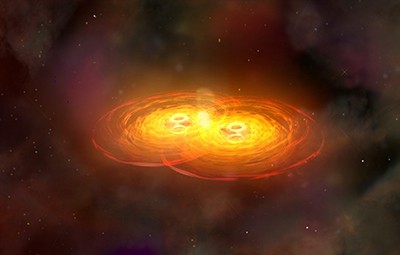
The theoretical framework underlying gravitational waves may have to be revamped to account for dark energy and the acceleration of the expansion of the universe. That’s the conclusion of researchers in the US, who say that while gravitational waves from nearby sources will be unaffected, next-generation detectors such as the Laser Interferometer Space Antenna (LISA) and the Einstein Telescope – which aim to detect gravitational waves from billions of light-years away – may fall foul of the expansion of the universe. While such telescopes will still detect gravitational waves, the signal detected from more distant waves could be fairly different to what is currently expected, say the researchers.
Dark energy is best explained by a small but positive value for the cosmological constant, which describes the energy density of space. It was the famous factor that Albert Einstein discarded from his general theory of relativity, when it was found in 1929 that the universe was expanding. For the next 69 years, theorists assumed that the cosmological constant was equal to zero. However, in 1998, it was discovered that the expansion of the universe was accelerating, driven by the mysterious dark energy, and the cosmological constant was back in the running.
Because the value of the cosmological constant is very small (10–52 m2), it had been assumed that it would have a negligible effect on the mathematical descriptions of gravitational waves. However, Abhay Ashtekar and colleagues at the Institute for Gravitation and the Cosmos at Penn State University in the US believe that it throws a spanner into the works of our current gravitational-wave theories.
Gravitational kicks
“Even a tiny cosmological constant casts a long shadow on the theory of gravitational waves,” says Ashtekar. He told physicsworld.com that “the current theory, laid down some 50 years ago by Hermann Bondi, Rainer Sachs and Roger Penrose, makes such strong use of the assumption that the cosmological constant equals zero that it now has to be rebuilt, starting from its foundations.”
Ashtekar and team have already begun this process, deriving a new generalization for Einstein’s famous quadrupole formula, which describes the rate at which gravitational waves carry away energy from a system involving two or more massive objects, such as a binary black hole. The merger of two black holes into one can give the combined black hole a “kick” in one direction – the team’s work on modifying the quadrupole formula describes a more accurate version of these kicks.
Even a tiny cosmological constant casts a long shadow on the theory of gravitational waves
Abhay Ashtekar, Penn State University
However, rebuilding the overall theoretical framework of gravitational waves developed by Bondi, Sachs and Penrose in the 1960s is a far greater challenge. “For a cosmological constant greater than zero, we do not yet know what gravitational waves mean in full general relativity, nor do we have expressions for the energy and angular momentum that they carry,” says Ashtekar.
Going the distance
According to the Penn State trio, the effect of the cosmological constant is a cumulative one – the more distant a gravitational-wave-emitting object is, the more expanding space the gravitational waves have to cross to reach us, and therefore the greater the effect of the cosmological constant on them.
The current generation of ground-based detectors, such as Advanced LIGO, can only detect gravitational waves from objects up to about 800 million light-years away – according to Ashtekar, this is not far enough for the cosmological constant to have a noticeable effect. However, LISA and the Einstein Telescope should be able to detect gravitational waves from the other side of the visible universe, and the mathematical models for these signals will need revisiting.
“I’m intrigued by the claim that there might be some measurable consequences for very distant and long wavelength sources that future detectors might probe,” says Martin Hendry, at the University of Glasgow, who was not involved in the Penn work. He agrees with the team’s conclusion that current detectors looking at nearby sources won’t be affected by the cosmological constant.
Looking ahead
B S Sathyaprakash at Cardiff University, who was also not involved in the current work, suggests that “gravitational-wave signals that we detect from cosmological distances might carry the signature of dark energy,” and could be used to probe it. “It will be very interesting to see how our signals are modified by the inclusion of the corrections predicted by [Ashtekar’s] work, and this is what we look forward to doing in the coming years.”
The likes of LISA and the Einstein Telescope will not be operational before the 2030s, giving theorists the chance to rework the equations. Ashtekar says that it is “now clear that the reason the problem had remained open so long was because the inclusion of a cosmological constant, however small, requires a deep change in the basic conceptual structure and mathematical techniques needed to describe gravitational waves in full general relativity”.
The research is to be published in Physical Review Letters.



